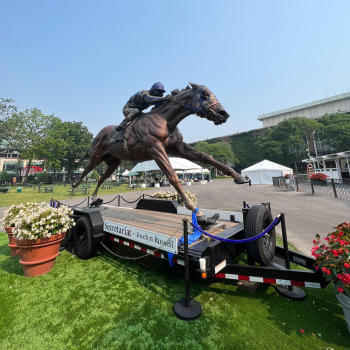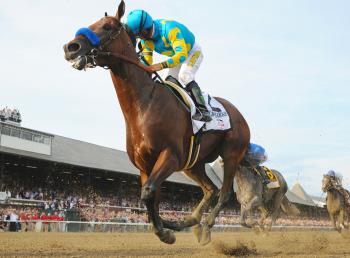The Belmont Stakes, the oldest of the Triple Crown races, will be held at historic Saratoga Race Course for the first time in 2024. The event has been an American institution since 1867.
America was in a traumatic struggle to piece itself back together from the physical carnage and emotional wreckage of the Civil War when the Belmont Stakes was run for the first time in 1867 at the grand old venue of Jerome Park in New York’s Westchester County. The Preakness Stakes was still six years away from its first edition and it would be another two years after that before the inaugural Kentucky Derby took place.
Today, with 155 runnings in the books, the Belmont Stakes is known by race fans throughout the world as “The Test of the Champion,” the defining third act of the Triple Crown series. The rich history of the Belmont will add a highly anticipated new chapter in 2024 when it is held on June 8 at Saratoga Race Course. A major renovation project currently in progress at Belmont Park led the New York Racing Association to move its prestigious Belmont Stakes Racing Festival to the Spa City for 2024 and 2025. Belmont Park, located in Elmont on Long Island, has played host to the Belmont Stakes since 1905 with the only exceptions being 1963 through 1967, when a previous construction project necessitated a move to Aqueduct. The race was not contested in 1911 and 1912, when the sport was shut down in New York because of anti-gambling crusaders.
From the great filly Ruthless winning the first running more than a century and a half ago to Arcangelo’s historic victory in 2023, the Belmont’s history is as revered as any thoroughbred race in the world. Thirteen horses — Sir Barton (1919), Galant Fox (1930), Omaha (1935), War Admiral (1937), Whirlaway (1941), Count Fleet (1943), Assault (1946), Citation (1948), Secretariat (1973), Seattle Slew (1977), Affirmed (1978), American Pharoah (2015), and Justify (2018) — have stamped themselves as immortals of the sport by securing victory in the Belmont following signature wins in Kentucky and Maryland, respectively.

Secretariat statue at Belmont Park (Belmont Stakes Facebook)
The Belmont took place at Jerome Park from 1867 through 1889. When that track closed, Morris Park — built near Jerome Park on land that was annexed into the Bronx — played host to the race from 1890 through 1904. The contest was named for August Belmont I, a wealthy financier and sportsman who helped fund Jerome Park’s construction and served as its first president. In May of 1905, a new facility opened in Elmont named Belmont Park in honor of the famed turfman.
The early years of the Belmont Stakes featured some of the top thoroughbreds in the sport’s history. Prior to Sir Barton becoming America’s first Triple Crown winner in 1919, the Belmont had already been won by eight horses that were eventually elected to the Hall of Fame: Ruthless (1867), Harry Bassett (1871), Duke of Magenta (1878), Hanover (1887), Henry of Navarre (1894), Commando (1901), Peter Pan (1907), and Colin (1908).
The term “Triple Crown” was not popularized until the 1930s, when Gallant Fox and his son, Omaha, came along. As accomplished as he was, inaugural Triple Crown winner Sir Barton’s legacy was quickly overshadowed when the mighty Man o’ War arrived on the scene. Owned by Samuel D. Riddle, Man o’ War was not entered in the Kentucky Derby in 1920, but he won the Preakness with ease and dominated the Belmont by 20 lengths.
The New York Times ran headlines describing Man o’ War’s Belmont victory as a “Speed Miracle” and featured subheads “WINS BELMONT BY A BLOCK,” “GREAT THRONG IS AMAZED” and “Experts Who See Flying Heels of Fair Play’s Great Son Spurn Distance Dub Him Horse of Ages.” The Times reported: “Samuel D. Riddle’s marvelous race horse, Man o’ War, gave at Belmont Park yesterday what was beyond a doubt the greatest exhibition of speed ever witnessed on any race track when he shattered the world’s record for a mile and three furlongs in winning the $10,000 Belmont Stakes, while a crowd of 25,000 sat stunned by the almost unbelievably brilliant performance. The champion did not just clip the mark, but literally shattered it, for he ran the distance in 2:14 1-5, which is two and three-fifths seconds faster than any horse had ever run it before.
“The world’s record was previously held by Dean Swift, which ran a mile and three furlongs in 2:16 4-5 at Liverpool, England, in 1908. The next lowest mark was made in the running of the Belmont last year when Sir Barton set a new American record for the distance of 2:17 2-5. The Canadian and Australian records do not even closely approach the English and American marks, which stood until yesterday afternoon. The race left no doubt in the minds of all turfmen present that they had seen the greatest horse of this or any other age. Man o’ War would seem to typify the final goal of breeders, the perfect race horse, gifted with all the essentials of greatness.”
Man o’ War was one of four future Hall of Famers to win the Belmont in the 1920s, along with Grey Lag (1921), Zev (1923), and Crusader (1926), a son of Man o’ War. The 1930s and 1940s were both golden decades for the Belmont, as 11 winners went on to the Hall of Fame, including Triple Crown champions Gallant Fox, Omaha, War Admiral, Whirlaway, Count Fleet, Assault, and Citation.
Count Fleet’s 25-length margin of victory stood as the Belmont record until Secretariat’s 31-length romp in 1973. Secretariat also ended a 25-year drought between Triple Crowns and his time of 2:24 set and remains both the Belmont and American record for the distance on dirt 51 years later. Track announcer Chic Anderson famously described Secretariat as a “tremendous machine” during his jaw-dropping Belmont run. More than 50 years later, the legacy of Secretariat and what he accomplished on June 9, 1973, remains the standard by which all others are measured in racing and, specifically, the Belmont.
The 1970s also produced Seattle Slew, the first horse to successfully navigate the gauntlet of the Triple Crown undefeated, as well as Affirmed, whose thrilling victory by a nose over Alydar in the 1978 Belmont concluded what is generally agreed upon as the greatest rivalry in the history of the Triple Crown series.
The Belmont has also been known for monumental upsets and has thwarted the dreams of many Triple Crown hopefuls. Twenty-three horses that won both the Derby and Preakness have failed in their attempt to win the Belmont, including greats such as Northern Dancer, Spectacular Bid, Silver Charm, Sunday Silence, and Alysheba, among others. A record crowd of 120,139 attended the 2004 Belmont when Smarty Jones was denied the Triple Crown by Marylou Whitney’s Birdstone. It was the third straight year a Triple Crown hopeful was denied in the Belmont. The gracious Whitney, understanding the impact of a potential Triple Crown on the sport, famously apologized to the owners of Smarty Jones for her horse winning the race. When California Chrome faded in the stretch of the 2014 Belmont with a Triple Crown on the line, many wondered if the sport would ever see another horse accomplish the feat.
Then came American Pharoah.

American Pharoah (Victor Espinoza up) racing in the 2015 Travers Stakes (Bob Mayberger)
Ending the 37-year drought, the son of Pioneerof the Nile became America’s 12th Triple Crown winner before a crowd of 90,000 in a time of 2:26.65, the sixth-fastest in the race’s history and second-fastest among Triple Crown winners. Three years after American Pharoah, the 13th Triple Crown winner, Justify, etched his name into racing history when he swept the iconic series.
In terms of historical significance, a total of 40 Belmont winners have been inducted into the Hall of Fame through 2023, more than both the Kentucky Derby (36) and Preakness Stakes (34).
So who will be the next to make Belmont history? We’ll find out on June 8 … at Saratoga!
Brien Bouyea is the Hall of Fame and Communications Director at the National Museum of Racing and Hall of Fame and the author of the books Bare Knuckles and Saratoga Racing: The Remarkable Life of John Morrissey and The Travers: 150 Years of Saratoga’s Greatest Race.

